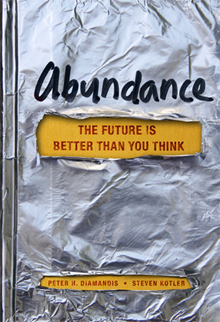|
If Stephenson’s world of inexpensive diamonds sounds farfetched to you,
consider the entirely factual tale that Diamandis and Kotler use to kick
off their book. Once upon a time, you see, aluminum was the world’s most
precious metal. As late as the 1800s, aluminum utensils were reserved
for the most honoured guests at royal banquets, the other guests having
to make do with mere gold utensils. But in fact, aluminum is the third
most abundant element in the Earth’s crust, behind oxygen and silicon. It
makes up 8.3 percent of the mass of the planet. But it is never found in
nature as a pure metal, and early procedures for separating it out of
the claylike material called bauxite were prohibitively expensive.
Modern procedures have made it so ubiquitous and cheap that we wrap our
food in it and then discard it without so much as a second thought.
The moral of the story is that scarcity is often contextual. Technology,
as the authors explain, is a “resource-liberating mechanism.” And the
technologies being developed right now have the power to liberate enough
resources to feed, clothe, educate, and free the world.
 Peter Diamandis is the Chairman and CEO of
the X PRIZE Foundation, best known for the $10-million Ansari X PRIZE
that launched the private spaceflight industry. He conceived of the
project back in 1993 after reading Charles Lindbergh’s The Spirit of
St-Louis (1954) and learning about the $25,000 prize funded by
Raymond Orteig that spurred Lindbergh to make the first ever non-stop
flight from New York to Paris in 1927. Diamandis also holds degrees in
molecular biology and aerospace engineering from MIT and a medical
degree from Harvard.
Peter Diamandis is the Chairman and CEO of
the X PRIZE Foundation, best known for the $10-million Ansari X PRIZE
that launched the private spaceflight industry. He conceived of the
project back in 1993 after reading Charles Lindbergh’s The Spirit of
St-Louis (1954) and learning about the $25,000 prize funded by
Raymond Orteig that spurred Lindbergh to make the first ever non-stop
flight from New York to Paris in 1927. Diamandis also holds degrees in
molecular biology and aerospace engineering from MIT and a medical
degree from Harvard.
Diamandis and his co-author, best-selling writer and journalist Steven
Kotler, do not attempt to paper over the plight of the world’s poor, who
still lack adequate clean water, food, energy, health care, and
education. Still, there has been significant progress “at the bottom” in the past
four decades. “During that stretch, the developing world has seen longer
life expectancies, lower infant mortality rates, better access to
information, communication, education, potential avenues out of poverty,
quality health care, political freedoms, economic freedoms, sexual
freedoms, human rights, and saved time.”
It is technology that has improved the lot of many of the world’s poor,
and in Abundance, we get a quick tour of dozens of the latest
exponential technologies that are poised to make serious dents in
humanity’s remaining scarcity problems. There is the Lifesaver water
purification system, the jerry can version of which can produce 25,000
litres of safe drinking water, enough for a family of four for three
years, for only half a cent a day. There is aeroponic vertical
farming—essentially a skyscraper filled with suspended plants on every
floor being fed through a nutrient-rich mist—which requires 80 percent
less land, 90 percent less water, and 100 percent fewer pesticides than
current farming practices. There are advances that promise to make solar
power more affordable and easier to store, which is going to be huge
given that “[t]here is more energy in the sunlight that strikes the
Earth’s surface in an hour than all the fossil energy consumed in one
year.”
|

